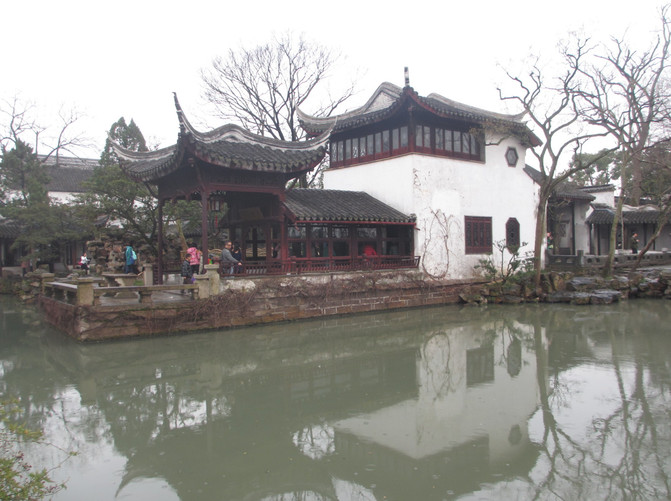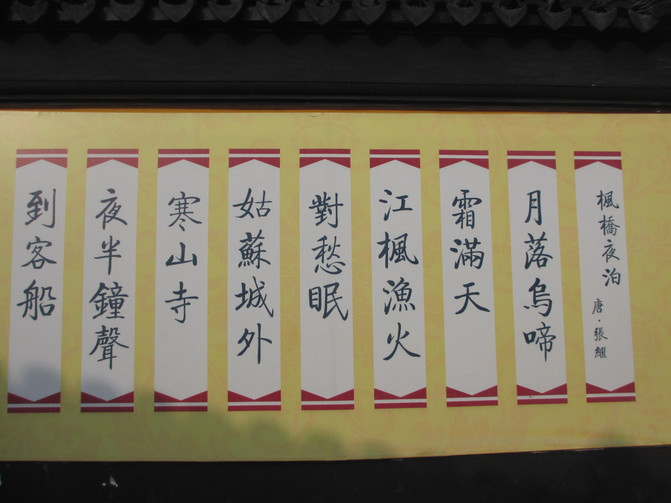A62-014. Domestic Tour with Wife and Daughter: 2015 Winter Holiday East China New Year's Eve Tour (D2)
Day2 (February 15)
A. Shanghai-Suzhou (G7006 high-speed train from 9:00 to 9:25).
B. Arriving in Suzhou, check in at the hotel (check in at Jinjiang Inn Suzhou Railway Station North Square, the hotel is located in Suzhou Railway Station North Square, less than 100 meters from the Suzhou Railway Station Exit. Book by Ctrip, 179 yuan/night).
C. Visit Humble Administrator's Garden (No. 529 Bus Station Beiguang Station-Suzhou Museum Station).
D. Visit the Lingering Garden (take a taxi from Humble Administrator's Garden to the Lingering Garden, the fare is 12 yuan).
E. Wandering in front of Hanshan Temple (take a taxi from the Lingering Garden to Hanshan Temple, the fare is 10 yuan).
F. Xindao Coffee and Dinner downstairs of the hotel (Take a taxi from Hanshan Temple to Suzhou Railway Station, fare 16 yuan).
Nanjing Road pedestrian street

The forecast light rain arrived as scheduled. In the early morning, the Nanjing Road Pedestrian Street with no one in the rain is a different scene.
Nanjing Road pedestrian street

Jiangsu
Jiangsu, referred to as "Su", is located in the middle of the eastern coastal area of the mainland of China, at the lower reaches of the Yangtze River and Huaihe River. It governs 13 prefecture-level cities (including 23 county-level cities, 24 counties, and 55 municipal districts), covering an area of approximately 102,600 square kilometers and a population of approximately 75.14 million.
Suzhou railway station

Suzhou
Suzhou was called Wu in ancient times, Su for short, also known as Gusu, Pingjiang, etc. It is a prefecture-level city in Jiangsu Province. It is located in the southeast of Jiangsu Province and in the middle of the Yangtze River Delta. It governs Gusu District, Xiangcheng District, Huqiu District, Wuzhong District, and Wujiang District. It administers Zhangjiagang City, Changshu City, Taicang City and Kunshan City, with an area of about 8,488.42 square kilometers and a population of about 6.54 million.
Suzhou Museum, Zhong Wang Fu, Suzhou Garden Museum and Humble Administrator's Garden are located on the same pedestrian street.
Suzhou Museum

The new location of Suzhou Museum was originally part of Humble Administrator's Garden and was designed by the famous Chinese architectural designer I.M. Pei.
Zhongwangfu

Zhong Wang Fu was originally a residence in Humble Administrator's Garden, and later served as the residence of Li Xiucheng, a famous general of Zhong Wang in the late Taiping Kingdom. It was preserved separately in the name of Zhong Wang Fu.
Suzhou Garden Museum

Suzhou Garden Museum was also the residential part of Humble Administrator's Garden.
zhuozhengyuan
Humble Administrator's Garden is located in the northeastern corner of the ancient city of Suzhou (No. 178 Northeast Street). It is the largest classical private garden in Suzhou. It was built in the early years of Zhengde in the Ming Dynasty (early 16th century) and has a history of more than 500 years. The entire garden covers an area of 78 acres (about 52000 square meters), it is divided into four parts: east, middle, west and residential areas. The residential area is a typical Suzhou dwelling house and is arranged as an exhibition hall of a garden museum. Most of the existing buildings in the Humble Administrator's Garden were rebuilt when it became the Zhongwang Palace Garden of the Taiping Rebellion in the Qing Dynasty (AD 1850). By the end of Qing Dynasty, three relatively independent small gardens were formed in the east, middle and west.
The ticket price for Humble Administrator's Garden in the off-season is 70 yuan/person, and children under 1.4 meters are free of charge.
The Humble Administrator's Garden is one of the four famous gardens in China. The Humble Administrator's Garden was originally built by Wang Xianchen, a censor who returned to his hometown in frustration in the Ming Dynasty. It has since been demolished and renovated repeatedly, constantly changing its owners. Listening to the history of Humble Administrator's Garden's constant changing masters, the world's changing masters will be lamented spontaneously.
The Eastern Garden of Humble Administrator's Garden is decorated with Yunfeng Mountain

This Taihu Lake stone is named Zhuifeng Peak and is located at the entrance of the eastern garden of Humble Administrator's Garden. The eastern garden has an open landscape and an idyllic scenery.
Humble Administrator's Garden East Garden

Humble Administrator's Garden East Garden

Humble Administrator's Garden East Garden

Humble Administrator's Garden East Garden

Humble Administrator's Garden Middle Garden

The Beisi Tower a few miles away is integrated with the garden scenery, using the method of borrowing scenery. It is said that this design came from Wen Zhengming, one of the four great talents in Jiangnan, and the central garden has also become the essence of the entire Humble Administrator's Garden.
Humble Administrator's Garden Middle Garden

Humble Administrator's Garden Middle Garden Xiangzhou

Buildings with stone boat-shaped shapes seem to have become the rule for landscaping.
Humble Administrator's Garden Middle Garden Xiangzhou

Humble Administrator's Garden Middle Garden

Humble Administrator's Garden Western Garden

The perfect combination of fan pavilion and Li pavilion symbolizes the owner of the garden who started his business as a fan and wanted to seek greater fame.
Humble Administrator's Garden Western Garden

Humble Administrator's Garden Western Garden

Humble Administrator's Garden Western Garden

Copper coins and flowers are metaphor for spending money.
Humble Administrator's Garden Western Garden

Humble Administrator's Garden Western Garden

lingering garden
The Lingering Garden is located at No. 338 Liuyuan Road, Changmen Gate, Suzhou. It covers an area of 23300 square meters. The current garden is divided into four parts. The east is dominated by buildings, the middle is a landscape garden, the west is a large rockery with earth and stone, and the north is a pastoral scenery.
The Lingering Garden was built in the 21st year of Wanli of the Ming Dynasty (1593 AD). It was a private garden owned by Xu Tai, Shaoqing of Taipu Temple. It was called the East Garden at that time. In the 59th year of Qianlong of the Qing Dynasty (1794 AD), the garden was acquired by Liu Shu in Dongshan, Wu County. After building, it was renamed "Hanbi Villa", commonly known as "Liu Garden". In the 12th year of Tongzhi (1873 AD), the garden was purchased and renovated by Shengkang, Changzhou. It was commonly known as Liu Yuan because the former owner's surname was Liu. Shengkang was a model of Suiyuan, and the pronunciation was changed. Change your name to Lingering Garden.
The Lingering Garden is one of the four famous gardens in China. The ticket price in the off-season period of the Lingering Garden is 45 yuan, and children under 1.4 meters are free of charge.
The Lingering Garden is also repeatedly abandoned and repaired, and its owners are constantly changing.
lingering garden

lingering garden

lingering garden

Lingyuan Wufeng Fairy Hall

Lingering Garden Wufeng Fairy Hall Marble

Lingering Garden Wufeng Fairy Hall rosewood ginkgo gauze screen

lingering garden

Lingyuan Guanyun Peak

Lingyuan Guanyun Peak

The marble, mahogany ginkgo gauze screen and Guanyun Peak in Wufeng Fairy Hall are called the Three Treasures of the Lingering Garden.
Lingyuan Xiaopenglai

Hanshan Temple Outer Wall

Zhang Ji's "Night Mooring on Maple Bridge" in the Tang Dynasty made Hanshan Temple famous far and wide.
Hanshan Temple Outer Wall

The outer wall of Hanshan Temple is filled with ancient poems singing Hanshan Temple and Maple Bridge.
Hanshan Temple Zhaobi

Hanshan Temple Zhaobi is a must-see place for tourists to take photos.
Jiangcun Bridge

The Jiangcun Bridge in front of Zhaobi of Hanshan Temple was built in the Tang Dynasty. The bridge was now rebuilt in the sixth year of Tongzhi of the Qing Dynasty (1867). The Jiangcun Bridge is the "river" where "river maple, fishing fire and sorrow sleep".
Jiangcun Bridge

Previous Article:The reason for staying in Zhenze is that eating tea is the most important thing
Next Article:Four Points by Sheraton Suzhou Hotel Southeast Asian Food Festival is in progress
